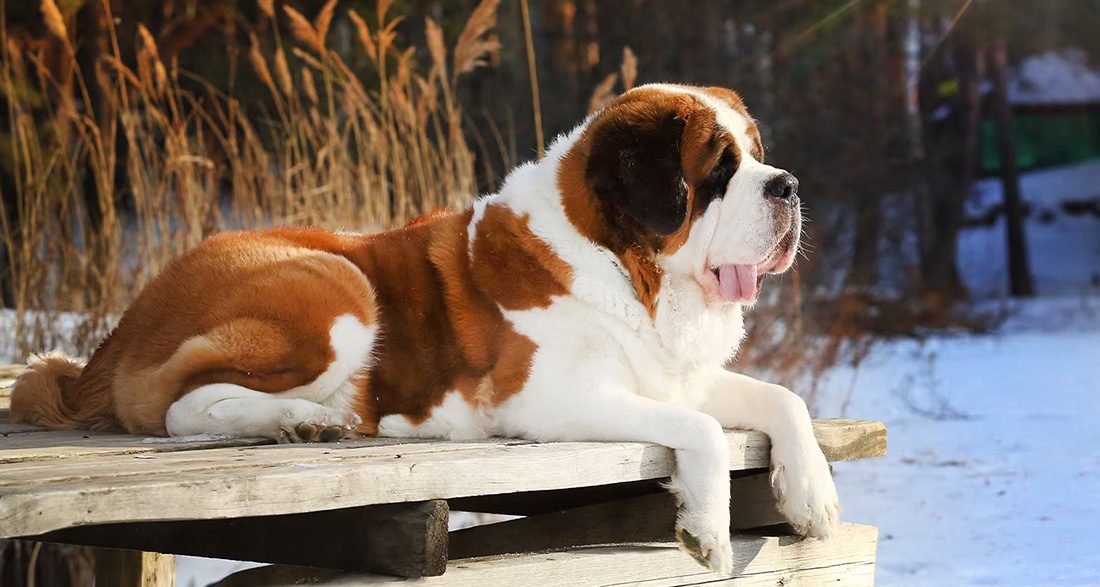A courageous avalanche rescue dog with a small barrel around its neck – this is how many envision the Saint Bernard. Today, this renowned breed from Switzerland is primarily a family dog. Find out everything you need to know about the history, temperament, and care of the breed in this profile.
History of the Saint Bernard
The dogs of the hospice on the Great St. Bernard Pass have been known as Saint Bernards since the end of the 17th century. According to legend, the hospice was founded in 1050 by the Augustinian monk “Bernard of Menthon” to protect the numerous travelers and pilgrims crossing the Alps at St. Bernard. The monks obtained dogs from the surrounding area, where the Bernese Mountain Dogs originated, and started breeding.
In the beginning, the dogs hardly resembled their present appearance. It wasn’t until the 19th century that the uniform appearance of the pass dogs developed, and the first long-haired specimens appeared.
Swiss Symbol
The breed gained widespread recognition, especially for its use as avalanche rescue dogs by the Augustinian monks. The most famous representative of the breed is the legendary avalanche rescue dog Barry, who is said to have saved over 40 people’s lives. When he died of old age in Bern in 1814, he was stuffed and is now displayed at the entrance of the Natural History Museum.
Since 1884, he has been considered the Swiss national dog, and in 1887, the Swiss standard was generally recognized. Due to the breed’s development toward higher weight and size, today’s representatives are no longer suitable for such tasks. Nowadays, they are mainly used as guard and family dogs. Internationally, the breed belongs to FCI Group 2, “Molossoids,” in Section 2.2, “Mountain Dogs.”
Breed Overview
GROUP: Working
HEIGHT: 26 to 28 inches (female), 28 to 30 inches (male)
WEIGHT: 120 to 140 pounds (female), 140 to 180 pounds (male)
TEMPERAMENT: Gentle, affectionate, protective
COAT: Short to medium-length, smooth or rough double coat
COAT COLOR: Brindle and white, brown and white, mahogany and white, orange and white, red and white, or rust and white with/without a black mask
HYPOALLERGENIC: No
LIFE SPAN: 8 to 10 years
Traits and Characteristics
The Saint Bernard is a gentle, good-natured, and affectionate family dog. These easygoing dogs remain unflustered and are very patient with children. They need close contact with their humans and, despite their size, love to be everywhere. Despite their calm nature, the dogs are watchful in the face of danger and protectively stand by their families. Most representatives of the breed are selfless and would do anything for their family. However, Saint Bernards are not recommended for novice dog owners. They require experienced handling in training.
If something displeases them, the large dog can be stubborn and obstinate. With a loving upbringing, they become lifelong loyal companions. A special feature of the Saint Bernard is its excellent sense of smell and the reliable instinct that remains from its time as an avalanche rescue dog.
| Affection Level | High |
| Friendliness | Medium |
| Kid-Friendly | High |
| Pet-Friendly | Medium |
| Exercise Needs | Medium |
| Playfulness | Medium |
| Energy Level | Medium |
| Trainability | Medium |
| Intelligence | Medium |
| Tendency to Bark | Low |
| Amount of Shedding | Medium |
Appearance of the Saint Bernard
The Saint Bernard is a distinctive dog that even laypeople can immediately recognize. It is one of the largest and heaviest dog breeds in the world. The body is harmonious and muscular, with an imposing, large head and an attentive expression. The long or short-haired coat is very dense and lies smooth, with the base color being white with smaller or larger reddish-brown patches. Desired markings include a white collar and a symmetrical reddish-brown mask.

Puppy Training
The good-natured and patient Saint Bernard needs consistent training as a puppy, primarily due to its strength and size. What it doesn’t learn as a young dog can be challenging to teach in adulthood. Especially if you don’t want the large dog sitting next to you (or on you) on the couch, you should prohibit it from the puppy stage. It’s best to attend a puppy school with the exuberant puppy, where it can playfully learn the first commands and make contact with other dogs. Generally, these intelligent and good-natured dogs learn quickly but take their time. Despite their fundamentally calm and friendly character, you should remain consistent and always motivate the little one.
Activities with the Saint Bernard
The Saint Bernard is a calm and relaxed dog with a less intense need for exercise than other large breeds. It is not very fond of dog sports and prefers quiet walks. Fetching balls, frolicking, and jumping can quickly become too much for these somewhat sluggish dogs. Especially in summer, dogs with thick coats usually have little interest in physical activity. In winter, these dogs are in their element, and many representatives of the breed really come to life when there’s snow. For their fitness, you should ensure they get daily walks throughout the year.

Health and Care
Regular grooming is essential for the long-haired dogs. Additionally, many Saint Bernards suffer from teary eyes, which should be given special care. Many representatives of the breed tend to have strong drool, so slobber stains come with the territory. Especially important in raising a large puppy is to allow healthy development of bones and joints. Don’t overstrain the young dog, and don’t let it climb stairs or play too much. The breed is often affected by hip dysplasia and other joint problems, such as arthritis. Unfortunately, like most large breeds, the Saint Bernard has a relatively short life expectancy of only 8 to 10 years.
Is the Saint Bernard Suitable for Me?
The Saint Bernard is a good-natured and easygoing family dog that is not suitable for apartment living due to its size. It has a large space requirement, considering it can weigh up to 90 kilograms and reach a height of up to 90 centimeters! Ideally, a house with a spacious garden where the Saint Bernard can roam and stand guard would be suitable. Sufficient time and money for care and engagement are basic requirements for the keeping of any dog. If you are certain that you want to welcome a representative of the breed into your home, you must first find a reputable breeder, preferably one registered with the St. Bernard Club e.V. For a healthy puppy, you can expect prices between $1500 and $2000. You can also find dogs in need of a new home at the animal shelter or through the St. Bernard in Need association.
Interesting and Worth Knowing
At its place of origin, the Great St. Bernard Pass, the Saint Bernard has become a genuine tourist attraction. Even though the dogs have not been officially bred there since 2005, approximately half of the breeding dogs are at the hospice during the summer months. The monks offer a variety of souvenirs featuring the legendary dogs. From stuffed animals to stamps to refrigerator magnets, the dogs can be found everywhere.
The fame of the breed was also contributed to by the cult film “Beethoven,” which was released in 1992. The Newton family encounters an adorable Saint Bernard puppy. They welcome him into the family and name him Beethoven. The cheeky puppy transforms into an 80-kilogram dog within a few months, completely turning the family’s life upside down. In the comedy, you can see him constantly coming up with new and amusing antics.
Saint Bernard Overview
Pros
- Gentle and affectionate
- Eager to please
- Typically good with kids
Cons
- Drools a lot
- Has a relatively short lifespan
- Requires training to prevent jumping and leash pulling
Do you have a Saint Bernard or are you planning to get one soon? Tell me in the comments what makes this breed so special!


